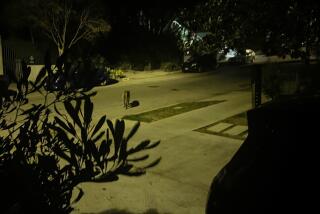Rights of Men, Animals Clash in Kenya
- Share via
NAROK, Kenya — Lions and elephants move freely through the rich wheat and cattle country of southwestern Kenya--a sight that fills people here with dread.
The protected animals, so popular with tourists, threaten not only crops but the very lives of the local residents, driving some to launch a counterattack.
In January in the Narok district three teen-age Masai herders took up spears to kill a lion that attacked their cows.
“I’ve had problems with lions before,” said Parseni ole Naiji, 15. The lion had mauled him, raking his back with its claws.
Two weeks earlier a woman was trampled to death near Narok when a herd of elephants came down from the nearby woods to feast on the terraced gardens of banana trees and vegetables near the Engare Siapei River.
“We get at least one patient a month with injuries from wildlife, but it is no surprise if we get several in a month,” said Dr. Peter Murumbu, Narok’s chief medical officer.
“We had a meeting here and there were a lot of complaints, with people saying we want to plant but the elephants eat all our maize (corn), and maybe they are being overprotected,” he said.
Conflict between people and animals occurs throughout Kenya and is getting worse. The population is growing by 4% a year and is expected to double to 44 million within 18 years.
Because of the population crush, Kenyans are seeking more and more farmland--even if it is in areas where wild animals are common.
In places like Narok, which borders the Masai Mara National Park, the problem is becoming clear.
“Those living adjacent to game sanctuaries in other parts of the country live in perpetual dread of the almost certain visits from elephants looking for food or running away from poachers,” said the Daily Nation newspaper in a recent editorial sharply criticizing the Wildlife Department’s protection efforts.
Recently elephants trampled a boy to death near Tsavo National Park in southeastern Kenya while a crocodile killed an elderly woman by the Tana River in the northeast.
Wildlife officers are still tracking a leopard that has been killing sheep and goats in the coffee-growing Kiambu district near Nairobi since mid-December.
“With more and more people on the land, now there is conflict where there was none in the past,” said John Boshe, a Tanzanian ecologist working in Nairobi.
“I’m afraid that the attitude of the general public toward wildlife isn’t very good. People don’t see the value of this wildlife,” he said.
“And if you go and say to a farmer you must move your shamba (Swahili for farm) away from the wildlife, that would make things even worse,” Boshe said.
To ease the problem of maintaining the wildlife herds--which attract valuable tourist dollars--Kenya pays compensation when people are killed or their farms are damaged by wildlife.
Kenya has budgeted about $537,000 for the year ending in June, up more than 40% from the $378,000 set aside the year before. But as of the end of 1986, claims totaling about $10.6 million were outstanding.
The political problem could become acute.
“There’s been too little money paid, just peanuts,” said a spokesman for the Kenya National Farmers Union.
“We are keeping those animals there, allowing them to wander free from harm, but all we are asking is that if they damage our crops, we be compensated,” he said.
Already one member of Parliament has introduced a private bill--a rarity in Kenya’s one-party system--calling for some wildlife reserves to be turned over to farmers.
In response to his questioning in parliament, Assistant Tourism and Wildlife Minister Philip Leakey said late last year that of 88 people killed by wild animals since 1980 in just one district, Tana River, 55 death claims had been paid at about $1,600 each.
A lack of funds was delaying the other payments, he said.
More to Read
Sign up for Essential California
The most important California stories and recommendations in your inbox every morning.
You may occasionally receive promotional content from the Los Angeles Times.













